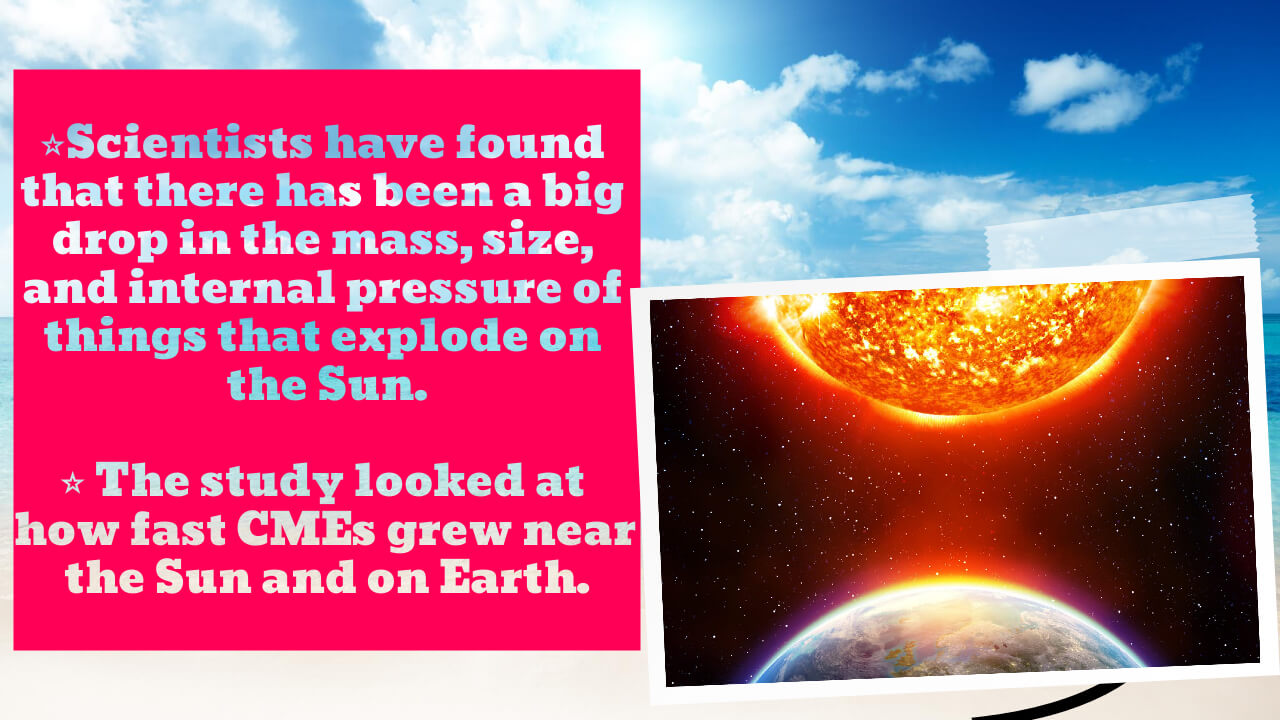There has been a big drop in the mass, size, and pressure inside the Sun’s explosive events. It is called Coronal Mass Ejections, or CMEs, and these eruptions happen on the surface of the Sun. They are very powerful. Because of the way they work, these eruptions can send a billion tons of very hot gas into space. Sun loss of quasi-steady matter was 10% less in cycle-24 than in cycle-22. The expansion history of CMEs, which is based mostly on the difference in total pressure between the CME and the space around them, is hard to understand.
Key Highlight:
- Scientists have found that there has been a big drop in the mass, size, and internal pressure of things that explode on the Sun.
- This is because of the solar cycle 24, which ran from 2008 to 2019.
- In their research, the team looked at the Earth-facing CMEs and the interplanetary counterparts of CMEs (ICMEs) using public data from the Solar and Heliospheric Observatory (SOHO) and the Advanced Composition Explorer (ACE), both of which were launched by NASA in 1995 and 1997, respectively.
- The study looked at how fast CMEs grew near the Sun and on Earth.
- Highlighting how important it is to keep an eye on CMEs, scientists say that CMEs need to be looked at at different distances from the Sun to understand better how their radial sizes change and how they spread out.
The Indian scientists are now trying to figure out why the Sun hasn’t been as active as it used to be in the last 11 years.
Scientists have found that there has been a big drop in the mass, size, and internal pressure of things that explode on the Sun. This conclusion is based on a comparison of the 2008-2019 11-year cycle-24 of solar activity on the Sun with the previous cycle, which ran from 1999 to 2008.
Over the last few decades, the average size of CMEs, or coronal mass ejections has been two-thirds of what it was in the previous cycle. This is because of the solar cycle 24, which ran from 2008 to 2019. The Indian Institute of Astrophysics, a government-owned institute in Bengaluru, is one of the scientists who led the study.
It is called Coronal Mass Ejections, or CMEs, and these eruptions happen on the surface of the Sun. They are very powerful. They happen because the Sun’s magnetic field isn’t stable enough. Because of the way they work, these eruptions can send a billion tons of very hot gas into space. When one is aimed at Earth, it isn’t just the other planets that are in danger.
Scientists have been puzzled by this reduction in average radial size because they thought that CMEs were expanding into interplanetary space to a much larger size, which would have led to large radial sizes. However, they found the opposite was true, a Ministry of Science and Technology note said.
He said that the lower pressure in interplanetary space in cycle 24 was compensated for by a lower magnetic content inside CMEs, which didn’t let the CMEs grow enough in the later propagation stages. This was a surprise. The scientist’s explanation is backed up by the fact that solar cycle 24 didn’t have as many solid and big CMEs as cycle 23 did. This caused fewer geomagnetic disturbances.
They also found that the gas pressure in interplanetary space was only 40% of the pressure in cycle 23. This isn’t the only thing: In cycle 24, the Sun lost 15% less mass through these ejections. Because the Sun also lost 10% less quasi-steady matter in cycle-24 than in cycle-22, this is also true.
There is a Frontiers in Astronomy and Space Sciences journal in which this work has been. Professor Nandita Srivastava and Urmi Doshi, both from the M S University of Baroda, are co-authors. In their research, the team looked at the Earth-facing CMEs and the interplanetary counterparts of CMEs (ICMEs) using public data from the Solar and Heliospheric Observatory (SOHO) and the Advanced Composition Explorer (ACE), both of which were launched by NASA in 1995 and 1997, respectively.
The scientists said that the expansion history of CMEs, which is based mostly on the difference in total pressure between the CMEs and the space around them, was hard to understand. The study looked at how fast CMEs grew near the Sun and on Earth.
Highlighting how important it is to keep an eye on CMEs, scientists say that CMEs need to be looked at at different distances from the Sun to understand better how their radial sizes change and how they spread out.
So, knowing about this kind of activity from the Sun, especially how CMEs move across the sky, is essential because they can have a big effect on the Earth’s magnetosphere. They affect the near-Earth space environment, including satellites in low orbits, GPS, long-distance radio communications, and power grids.
Such a study could be done with the help of space missions like Aditya-L1, which will be launched by India next year, and the Parker Solar Probe, which NASA launched, and the Solar Orbiter, which ESA launched.





[…] Scientists in India study decreased explosive activities on the sun over… […]